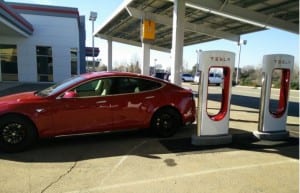Damn. Just as it appeared that driving cars might get exciting again, what with the arrival of electric vehicles en masse, it appears that particular luxury might be taken away from us.
As one technology advance gives us EVs, another related technology advance is threatening to take away that pleasure by giving us autonomous driving. And the reality is that this may not be just an option for bad or lazy drivers. It could become mandatory, and that leads inexorably down a single path, to the point where humans are banned from driving.
We’re starting to hear a lot more about the concept of “shared mobility”– a new era where the mix of electric vehicles, autonomous driving and shared vehicles, and a bunch of smart software and innovative business models – changes the way the global car industry is structured.
Already, Apple is investing more than it has in iPads, iPhone and Apple watches combined – and 20 times more than mainstream car manufacturers – on shared mobility R&D.
According to analysts at investment bank Morgan Stanley, it is looking to capture a share of the $2.6 trillion shared mobility industry that could dwarf its current smart phone market. And that could just as easily jump to a $10 trillion a year market in a matter of years.
And here’s the thing about “shared mobility”. One, it makes smarter use of an asset, personal motor cars, that are probably only used on average one hour a day. And then it maximises use of a share vehicle by doing away with the biggest bottleneck, finding and hiring a human to drive it. And then comes the issue of insurance and safety. If a robot and smart software can avoid traffic accidents and deaths, will authorities risk the human factor?

“Once high volumes of statistical data for your autonomous miles are collected and analysed, I can’t help but get out of my mind,” Jonas began.
“I have this image of you and some CEOs of other auto companies and CEOs of other software and tech hardware firms testifying in Congress about the urgent need to replace these dangerous purely human-driven cars on the road with available affordable and proven, even L2-L3 technology or semi-autonomous that’s ready for introduction to dramatically improve the epidemic of traffic fatalities as like a national public health and safety priority.
“Am I crazy, Elon, about kind of that type of – that role for people in your position to play armed with the data empirically? And if I’m not crazy, then how soon do you think it would take for tech firms like you to have a sufficient quantity and quality of data to be able to make such a scientifically proven case?”
Musk clearly didn’t want to be known as the party pooper who wanted humans banned from driving, so he played a straight bat.
“Well, I already feel like – I mean, Tesla will argue for autonomous driving, but we’re not going to argue against manual driving,” Musk said.
“And I believe people should have the freedom to choose to do what they want to do. And, yes, sometimes those things are dangerous, but freedom is important.
“And if people want to drive, even if it’s dangerous, they should be allowed to drive in my view. But then the autonomous safety systems should be in there such that, even if you’re in manual mode, the car will still aid you in avoiding an accident.”
So, where are we going here?
I dug up a report written by Jonas and other Morgan Stanley analysts, into this shared mobility market that promises to upend huge industries – auto, oil and personal experience – and turn it into a new commodity, shared services.
It warns that human driving may quickly be seen as a major social health and safety risk that can be addressed by technology.
“We anticipate the urgency of tech proponents to communicate the benefits of autonomous cars to regulators and consumers that could change the perception of human driving as a public health and safety risk,” the authors write.
“Even if human driving can (and must) continue on public roads for many years to come, consumers may quickly perceive the task of operating their own vehicle as a risky lifestyle choice.”
They cite reports that traffic fatalities are likely to top 35,000 in the US alone. Worldwide, the figure was estimated by the World Health Organisation at 1.24 million in 2013. That is the equivalent of 3,400 per day. And that is probably underplaying the reality, particularly in China and India.
So what does this future look like? We’ll follow up in the next few days on a scenario for the world’s first autonomous city. But as Morgan Stanley underlines, it will take a brave and visionary city mayor to press go on autonomous driving and put transport into the hands of robots that can work intelligently and write their own programming.
“We do not for one moment wish to make light of the serious moral and ethical issues that surround increasing levels of responsibility of vital human functionality to a network of connected robots that can work ‘intelligently’ or write its own programming.
“Certainly no mayor wants to be the first elected official blamed for the death of a citizen by a robot, even if that robot correctly followed its software program.”
It will all come down to data. It will take millions, if not billions of kilometres of experience with semi and fully autonomous vehicles before this actually becomes a thing.
“In our view, the burden of proof will be on the tech firms to show that their early autonomous cars are not just safer than human driving… but potentially many thousands of times safer per mile than human driving,” the Morgan Stanley analysts note.
But coming it is. National politicians had ignored the issue until president Barack Obama raised it in his last State of the Union address in January.
He called for a 21st century transportation system and this was followed by a more detailed proposal from the White House that calls for an investment of $2 billion per year to launch a “new generation of smart, clean vehicles” and “pilot deployments of safe and climate smart autonomous vehicles”.
The budget also proposes $400 million per year to ensure these technologies are safely integrated into America’s transportation system. “Once again, we go back to the desire for the federal government to address the high incidence of motor-vehicle related fatalities and injuries on US roads,” Morgan Stanley wrote. “Our view is that the stakes are potentially too high for government to ignore this issue.”
 The report notes that Sweden is conducting a test on autonomous vehicles and the UK is providing numerous autonomous driving, including this fully-electric “Lutz Pathfinder” pod that will have a top speed of 15mph and will transport commuters from the Central Train Station to the city center in Milton Keynes.
The report notes that Sweden is conducting a test on autonomous vehicles and the UK is providing numerous autonomous driving, including this fully-electric “Lutz Pathfinder” pod that will have a top speed of 15mph and will transport commuters from the Central Train Station to the city center in Milton Keynes.
And don’t think there will be an economic argument against autonomous vehicles. Apart from the lives saved, Morgan Stanley says the payback time for autonomous driving could be as little as 18 days – yes, that’s 18 days.
That’s based on its assumption that the incremental cost (added costs) of autonomous driving over the price of current vehicles could be as little as $5,000, and that the worth of a human driver is $100,000. Based on an incremental cost of $155,000 and a driver cost of $30,000, the payback is still just 5 years and two months.
“At today’s prices, we estimate that the various hardware components needed to achieve full autonomous capability cost less than $US5,000 per car, which means that, together with R&D and other costs, the customer would pay a premium less than $10,000.
“We believe this is a reasonable premium to pay over a regular car given the benefits to the customer of a car that can drive itself. By the time fully autonomous cars are ready to be commercialized in 5-7 years, we expect the cost to be cut at least in half, with higher volumes and more mature technology.
“In fact, we believe autonomous vehicle technology is a smaller leap than full electric vehicles — which still need unknown battery breakthroughs in a lab or significant macro disruption to make them viable beyond being niche vehicles.”










